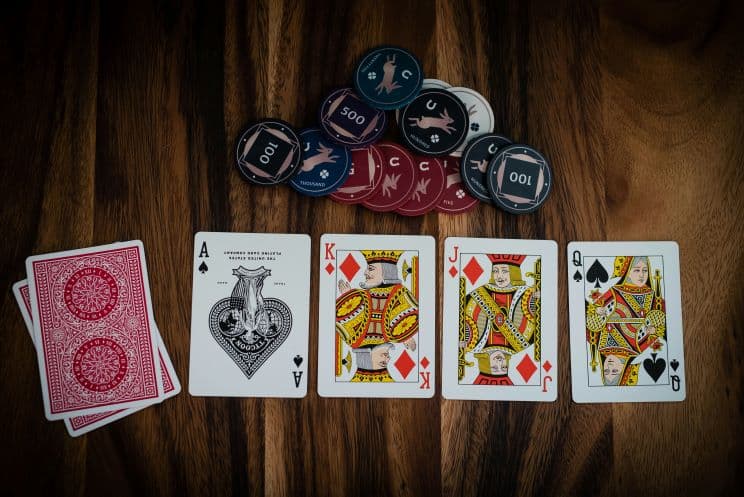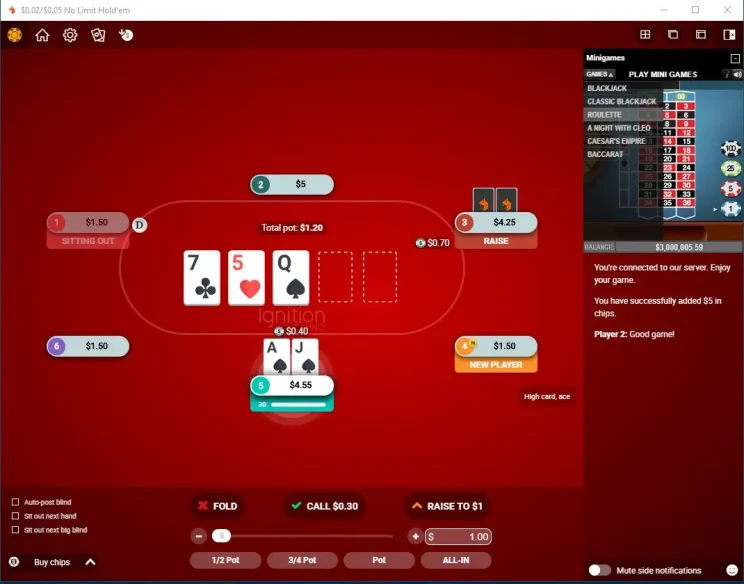Poker is as challenging as it is entertaining, and if you can master a few important skills, there’s money to be made. However, if you jump into a game without an understanding of basic poker strategy, you’re putting your bankroll at risk.
We don’t want you to do that, which is why we’ve written down our 10 best poker tips. Starting with the fundamentals and working up to some intermediate concepts, we’ve given you the perfect base on which to build a winning poker strategy.
Whether you’re aiming for $10 million WSOP payouts or you just want to clean up at your next home game at online poker site, here are 10 of the best poker strategies to master.
(Source: Chris Liverani/Unsplash)
Basic Poker Strategies: Getting Started
Everyone needs to start at the bottom if they want to know how to win at poker. That’s why we’re kicking off this guide with five important poker tips for beginners. The following concepts will give you a solid foundation on which to build a solid long-term strategy.
CoinPoker US 150% Deposit Bonus Up To $2,000 150% Deposit Bonus Up To $2,000
CoinPoker US
Play Now
Tip #1: Choose Your Starting Hands Wisely
(Source: Michael Parzuchowski / Unsplash)
You can’t learn how to be good at poker without knowing which cards to play and which ones to fold. It might sound basic, but every successful poker strategy starts with the cards you’re dealt and one decision: play or fold.
The first thing to say is that there are no right or wrong hands to play; there are only options. However, because we’re focusing on poker strategies for beginners, it makes sense to create a solid foundation.
So, for this discussion, we’re going to list hands that you should consider playing from three positions: early, middle, and late. As with everything in this poker strategy guide, we’ll be using Hold’em as our base, but the following concepts can be applied to any variant.
Each poker strategy chart we’ve created should be taken as a guide. For example, you might have 10-10 in late position. Normally, you’d play this hand. However, if there’s been a lot of action before it’s your turn to act, it might be best to fold.
Therefore, just because the chart says play, it doesn’t mean you should. Always consider the context. Additionally, each poker strategy chart shows a range of hands. If it says, “connected cards from 5-6 to 9-10,” that means all the connected cards between those two points.
#1: Early Position
Full-Ring Game (9 players)
| Hands to Play | Hands to Consider |
| 10-10 to A-A | 7-7 to 9-9 |
| A-J suited to A-K suited | A-10 suited |
| A-Q offsuit to A-K offsuit | K-J suited to K-Q suited |
Six-Max Game (6 players)
| Hands to Play | Hands to Consider |
| 7-7 to A-A | 6-6 |
| A-10 suited to A-K suited | A-10 offsuit |
| A-J offsuit to A-K offsuit | K-J suited and Q-J suited |
| K-Q suited |
#2: Middle Position
Full-Ring Game (9 players)
| Hands to Play | Hands to Consider |
| 9-9 to A-A | 7-7 to 8-8 |
| A-J suited to A-K suited | A-10 suited |
| A-J offsuit to A-K offsuit | A-10 offsuit |
| K-Q suited | K-J suited |
Six-Max Game (6 players)
| Hands to Play | Hands to Consider |
| 6-6 to A-A | 5-5 |
| A-9 suited to A-K suited | A-8 suited |
| A-10 offsuit to A-K offsuit | K-10 suited |
| K-J suited to K-Q suited | 10-9 suited to Q-J suited |
#3: Late Position
Full-Ring Game (9 players)
| Hands to Play | Hands to Consider |
| 7-7 to A-A | 5-5 to 6-6 |
| A-9 suited to A-K suited | A-8 suited |
| A-10 offsuit to A-K offsuit | A-9 offsuit |
| K-J suited to K-Q suited | K-10 suited |
| Q-J suited | 7-8 suited to J-10 suited |
Six-Max Game (6 players)
| Hands to Play | Hands to Consider |
| 4-4 to A-A | 2-2 to 3-3 |
| A-8 suited to A-K suited | A-7 suited |
| A-9 offsuit to A-K offsuit | K-J suited and Q-J suited |
| K-10 suited to K-Q suited | 5-6 suited to and Q-J |
Tip #2 – Players and Position Matter
All poker strategy is based on two fundamental concepts: players and position. The starting hand charts we’ve outlined above contain an increasing number of hands the later your position is. Why? Because acting late gives you more information.
You can get a better sense of what people have if they’ve already made a move. The first player to act doesn’t have any information, which is why it’s best to play tight and only open with a few hands.
In addition to position, make sure you know the players you’re up against. Opening with 4-4 in late position in a six-max game filled with passive players is fine.
Their passive tendencies mean they’ll play fewer hands, which, in turn, gives you more scope to take the lead with a wider range. If, however, the table is full of aggressive players, you might be better off folding 4-4, even though you’re in late position.
Tip #3 – Play Fewer Hands and Play Them Aggressively
Aggression is a skill you need to master in poker. In fact, aggression was one of the most important Texas Hold’em tips Doyle Brunson gave to the world in his book Super System. The key point to remember here is that you need to combine aggression with timing. This means sticking to a fairly narrow range of hands.
But, when you do decide to play a hand, try to be the aggressor as much as possible. One of the best ways to win at poker is to put opponents on the back foot so they make mistakes. You do that by playing tight (i.e., a few hands) and aggressively (i.e., betting and raising).
Tip #4 – Learn Pot Odds
You can’t learn how to win in poker if you don’t understand pot odds. Why? Every bet, raise, and call you make needs to be considered in relation to the money you can win, i.e., the chips in the pot. Poker strategy books define pot odds in the following way:
The ratio between the amount of money you need to call vs. the amount of money in the pot.
For example, if there’s $50 in the pot and it costs you $10 to call, you’re getting pot odds of 5/1, i.e., 50:10, which is simplified to 5:1. You use the pot odds to decide whether a call is justified or not. Advanced poker strategy deals with a variety of situations based on pot odds. However, for our basic poker strategy tips, we’ll focus on using them as a call vs. fold variable.
You do this by taking the total value of the pot and dividing it by the amount you have to call. Our example plays out like this:
- $50 pot + $10 call = $60 final pot
- $10 call / $60 final pot = 0.16 x 100 = 16%
The 16% figure tells us that you need to win more than 16% of the time to make a profit in this situation. At this point, look at your hand and estimate how likely it is to win against the range of hands your opponent could have. If it’s likely to win more often than the pot odds, call. If not, fold.
Tip #5: Don’t Go on Tilt
One of the simplest but hardest-to-implement poker tips we can give you is to not tilt. Going on tilt means you’ve lost control of your emotions. This causes you to make rash decisions and potentially blow your bankroll. You don’t want this to happen, so the trick is to remain calm as much as possible.
Remember that poker is meant to be fun. If you get a bad beat, shake it off and carry on. Every move you make in poker should be focused on its long-term potential. Go all-in with pocket aces against 7-2, and you’ll win way more often than you lose. Remember this fact, and short-term fluctuations won’t affect you as much.
Feel ready to play poker? Use our basic poker strategy tips at Bovada today.
Intermediate Poker Strategy Tips
Our basic poker strategy tips are enough to get you started. You could stop reading now, and the poker help we’ve given you so far would serve you well in micro-stakes games. However, if you’re anything like us, you’re probably aiming a bit higher than $0.01/$0.02 games.
If that’s the case, we’re going to build on our poker tips for beginners with five intermediate concepts. They’re not super advanced poker tips, so don’t worry. We’ve got other poker strategy articles covering pro-level tips. The following poker hints will be enough to take you from micro-stakes to low and mid-stakes games.
Tip #6. Everything Matters
A lot of basic poker strategies focus on fundamental concepts such as position and bet sizing. All of these poker tips are useful, but newbies tend to view them in isolation. In other words, they look at one Texas Hold’em strategy concept as distinct from another. The reality is that everything is interconnected.
You can’t think about position without taking into account player types. You can’t think about bet sizing without pot odds and implied odds. That’s why everything matters.
Of course, we’re not saying you need to know all of the best poker strategies right now. We’re simply saying that you need to merge individual tips to develop an overall strategy. This is how the pros think and how you need to think if you want to move beyond basic poker strategy.
Tip #7. Learn the Math
“Math is idiotic” used to be a meme, and a lot of old-school pros will give you poker tips that don’t have a mathematical foundation.
Playing with “feel” is fine, but the reality is that poker is a game of numbers, and you need to know them if you want to win. Some of the mathematical concepts you need to know are:
- Pot odds (see previous section)
- Implied odds
- Probabilities
- Expected Value
- Equity
- Fold Equity
The best poker strategy books to learn about these topics are:
Tip #8. Tell Convincing Stories
You’ll hear professional players talk about “lines” when they’re discussing hands and how to get better at poker. A line refers to the way a hand plays out and includes everything from the amount someone bet and their position to the time it took for them to make a decision.
Lines are, essentially, stories. The art of being a good poker player is learning to tell a convincing story. This poker strategy concept is most important when you’re bluffing. Skilled opponents can spot inconsistencies in your story from 100 paces.
Therefore, if you’re going to run a bluff, make sure you’ve told a coherent story. This means playing as though you’ve got a strong hand from the start. Don’t suddenly decide halfway through a hand that you’re going to bluff because the story won’t be believable. Identify a potentially profitable situation to bluff, then tell a convincing story.
Tip #9. Learn How to Be Good at Poker from All Angles
We’ve focused on Texas Hold’em tips in this guide, but the majority of things we’ve said can be applied to any variant. Indeed, poker strategy concepts such as pot odds, hand selection, position, and coherent lines apply to Omaha, Stud, Draw, and Mixed Games.
Therefore, you can take our poker beginner tips, combine them with our intermediate ideas, and test them in different variants. This will give you a better overall understanding of poker and how all of the best poker strategies are malleable.
There’s never a one-move-fits-all solution for every situation. You’ll learn this when you play games other than Hold’em.
Tip #10. Go GTO
Game Theory Optimal is a way of playing poker that bases each move on the mathematics of the situation. It’s, essentially, a statistically and logically unexploitable way to play. You’ll need to understand the fundamentals of GTO before you use this poker strategy. We suggest reading Modern Poker Theory as a starting point and for an overall grounding.
Once you’ve done that, start playing around with a GTO calculator to find the optimal moves for common scenarios in poker. You can keep it running alongside your poker app or desktop software as you play cash games.
Read More on Playing Poker to Win
Enhance your poker strategy with more of our premium guides:
- Read up on the top poker terminology
- Unearth top offshore poker sites
- Learn about poker bankroll management
- Learn poker positions
- Poker hands explained
Final Thoughts
We’ve given you the best poker strategies for beginners. We’ve sprinkled in some more advanced poker tips. We’ve even told you where to practice your newfound skills.
Something we haven’t addressed is cost. We can give you advice on how to win at poker, but it doesn’t mean you will. Nothing is guaranteed in this game, which is why it’s a good idea to play free poker games.
You can create an account at BetOnline right now and get access to play-money games and freerolls. Both of these options are perfect for anyone trying to master new skills because they don’t cost anything to play.
FAQs
What is the best strategy to use in poker?
Is poker a game of skill or luck?
What is the best position in poker?
What is the most profitable poker style?
Responsible Gambling
Mastering basic poker strategy isn’t a green light to play recklessly. The foundation of any winning strategy is responsible gambling. Never bet more than you can afford to lose, and never play longer than necessary. Check out our responsible gambling FAQ for more tips.































